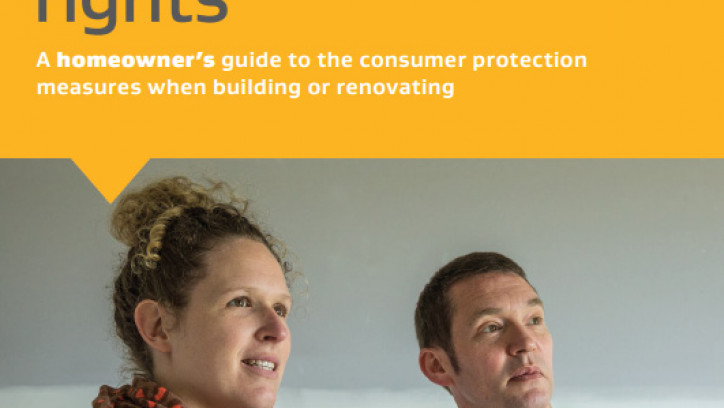Homeowner rights and obligations
Last updated: 18 December 2025

Most New Zealanders only contract or do significant building work once or twice in their lifetimes – knowing their rights and obligations will help them make informed decisions.
This information is written for homeowners, but is also relevant to owners of commercial property when doing building work.
This section gives you essential information about your rights and obligations as you build or renovate. It tells you what you need to do to ensure your building project complies with the Building Act 2004 and its regulations. This will help avoid potentially costly mistakes or delays and ensure your property is safe, healthy and durable. It also explains how the law will protect you if things don't go to plan.
Make sure you understand the building process and read all the sections relevant to your project before you start to build. These are general rights and obligations, with the full requirements set out in the Building Act 2004 and its regulations. If you use appropriately qualified professionals they should be able to assist you.
Stages of the building process can help you understand a typical build.
Building or renovating? Know your rights to build it right
Your first job in renovating or building is to understand consumer protection measures.
In the planning stage
The Building Act and its regulations set out the rules for building work. Other laws can affect your project, including council bylaws, the Resource Management Act 1991 and laws specifying that qualified professionals must do certain plumbing, gas and electrical work.
In general, the same rules apply whether you are doing the work yourself or contracting someone to do it for you.
It is the building owner’s responsibility to:
- apply for a building consent for proposed building work, if it's required (including construction, alteration, demolition and siteworks)
- provide the necessary information with the building consent application to confirm compliance with the Building Code
- notify the council about:
- who will do any restricted building work (provide the name(s) of the licensed building practitioners who will do or supervise the work)
- any changes to the consented plans as you progress
- a proposed change of use for the building, even when it doesn’t require a building consent
- an extension of life for a building with a specified life
- subdividing a property with an existing building
- any alterations, even if they don’t require a building consent (alterations can trigger upgrade requirements, such as smoke detectors or insulation)
- apply to the council for a code compliance certificate on completion of work that requires a building consent
- ensure that the building has a compliance schedule where this is a requirement of the Building Act (for example, if you have a cable car)
- ensure inspection, maintenance and reporting procedures are carried out where required by any compliance schedule for specified systems
- maintain the building in a safe and sanitary condition at all times
- if there are concerns about building safety in earthquakes, get professional engineering advice and act on it.
How the building system protects you
DIY work explains measures to ensure your own build is legal and safe.
If you are altering or changing the use of a building you must let the council know about the change, get their agreement and meet any requirements.
Change of use and alterations explains what this involves.
If you are an owner of a multi-unit or attached building you will need to take the rights of other owners into consideration in your planning of any build or renovation. You will also need to be clear about how you will make decisions. There can be different title types (for example, single title, unit title, strata title, cross lease, fee-simple, company share).
Find more information on shared responsibilities for unit title owners.
Contracting your rights and obligations
If you are using professionals for your build, you will benefit from getting at least one detailed fixed quote (preferably more). The person or organisation making the quote must keep to the price and build to the detail.
Tenders and quotes explains some options.
You must have a written contract for residential building work with a value of $30,000 or more (including GST). However, you can have a contract for any project, regardless of the cost.
A written contract can also be a good way to ensure you and your contractor understand your rights and obligations from the start of the project, so make sure your contract spells them out.
For example, your contract should include a payment schedule, a dispute resolution process and information about who does what in the building process.
Before you agree to any arrangement or sign a contract make sure you have seen the contractor’s disclosure statement and standard checklist. This includes standard information about the building process and the minimum requirements of a contract.
You must be given the disclosure statement and standard checklist if either:
- you ask for them
- your residential building project will cost $30,000 or more (including GST).
Consumer protection – disclosure statement and standard checklist
Your contract should include a payment schedule so you know what to pay, the work each payment covers and when it is due. You need to keep to the schedule or let your contractor know of any problems, as you are legally obliged to pay the money as scheduled.
Remember you have no obligation to sign a contract put in front of you. Seek legal advice and ensure it covers your needs.
Why contracts are valuable includes more information.
Contract problems includes information about payment disputes.
Building to the rules
Whether you are doing the work yourself or hiring professionals, you are responsible as the property owner for ensuring the work meets the relevant requirements.
All building work in New Zealand must meet the requirements of the Building Code, even if it doesn’t require a building consent.
In most cases you will need to get a building consent. This is an obligation in itself and the building consent application process should highlight any other legal obligations you need to meet.
Talk to your council at any stage to get a better understanding of your specific obligations. You can also have a look at the council’s file on your property, get a Land Information Memorandum (LIM) or a project information memorandum (PIM) for a fee.
Check if you need consents includes information about exempt work.
Your architect, builder or project manager might take on the role of obtaining the building consent but it is your responsibility, as the building owner, to ensure it is done. You can’t contract out of this obligation, but you can get someone to do it on your behalf.
It is important that you, your builder and tradespeople also build to the approved building consent. The property owner is responsible for ensuring the build happens as set out in the building consent, even if you rely on the main contractor to ensure this happens.
This includes making sure:
- council inspections occur as set out in the building consent
- work is carried out by people with the appropriate qualification (for example, gas, electrical or restricted building work)
- you advise the council of any changes to the consented plans and carry out any related requirements (variations or amendments)
- any ‘notice to fix’ is acted on and the work re-inspected (if the council identifies work that does not meet the Building Code requirements or contravenes the Building Act)
- you pay all required council fees
- you apply for council sign-off of the build (called a code compliance certificate).
Build to the consent provides more detail.
If a building owner fails to meet their responsibilities, councils can issue fines and penalties. There could be an initial fine, and further fines for every day the offence continues.
You also need to ensure your main contractor has a health and safety plan in place so people working on or visiting the site are not harmed.
Granny flats exemption
The granny flats exemption (also known in legislation as non-consented small standalone dwellings) under Schedule 1A of the Building Act 2004, enables eligible dwellings of up to 70 square metres to be built without a building consent, provided they meet specific design and construction conditions and are built or supervised by licensed professionals.
Granny flats exemption guidance has information about small standalone dwellings built using the granny flats exemption.
When work requires a licensed professional
Some parts of a residential build will require people with specific skills. This is especially the case where the work will directly impact on the safety of occupants or the durability of the finished building. You also need to ensure you use appropriately licensed professionals to do certain design work. This protects you and any future owners and users of the building.
A Licensed Building Practitioner (LBP) must do any work essential to structure or weathertightness (called restricted building work). You will need to let the council know who any LBPs are, preferably in your building consent application.
Your LBP must also provide you with documentation about the work they have done or supervised. It’s called a Record of Work or a Certificate of Work and you’ll need it to get the work signed-off by the council at the end of the build.
Some building professionals are able to do or supervise some restricted building work because of their qualifications. For example, architects, engineers, electrical workers, plumbers, gasfitters and drainlayers.
Restricted building work explains the requirements.
Owner-builder obligations is about DIY and restricted building work.
Check the Licensed Building Practitioners (LBP) website for more information or to find an LBP.
All work on a small standalone dwelling using the granny flats exemption must be carried out or supervised by licensed building professionals. This includes designers, builders and tradespeople, such as LBPs, architects, engineers, plumbers and electrical workers, who must work together to ensure the building work is safe, compliant and properly documented.
Granny flats exemption guidance explains the granny flat exemption
Other work requires licensed professionals but isn’t called restricted building work. For example, most gas or electrical work. The professional doing the work should give you an energy work certificate to show the work is safe and complete. You will also need this certificate if the work is part of a building project you are applying for the council to sign-off (for work that requires a building consent).
Energy work certificates includes links to relevant registration boards.
Get the right people for your project explains some of the different roles.
What to do with defects
Your main contractor must fix any defective building work or remedy any defective product notified to them within 12 months of the completion of the building work. After this 12-month period your rights and obligations will depend on the contract with your building practitioner. You could discuss progress at milestones in the project, including the quality of the work.
It should be much easier (and more time and cost effective) for them to repair any defective work or products as they go. If they wait until the end of the project the problems may be hidden by other building elements, or they may be moving on to their next project.
They will need to organise the repair of anything faulty related to the build. They are also responsible for the work done by subcontractors.
How to identify defects includes our Guide to tolerances, materials and workmanship.
Consumer protection at the end of a build (and for future owners)
At the end of your project, the council will only sign the work off as complete if it has been built as set out in the building consent. This provides you, and any future owners, with a level of assurance that the work meets New Zealand building requirements.
As there are no council checks or sign-offs when a small standalone dwelling using the granny flats exemption is completed, homeowners must collect and submit to the council, a range of records and certificates that confirm the work was carried out by appropriately licensed professionals and complies with the Building Code. These include:
- Certificate of Work (CoW) for any restricted design work
- Records of Work (RoW) from Licensed Building Practitioners (LBPs)
- Records of Work (RoW) from Registered plumbers and drainlayers
- Electrical safety certificate
- Gas safety certificate (if applicable)
- Energy work certificates (if applicable).
It is also important to keep supporting documentation such as site notes, photographic records, producer statements, and test results as they can provide further evidence of compliance and help meet lender, insurer, and future resale requirements.
At this point your building contractor needs to give you information about any ongoing maintenance requirements, insurance policies and guarantees or warranties related to your build. These will ensure you are able to meet any ongoing requirements to protect your investment.
Protecting your investment explains this more.
If you have problems once the build is complete there are several measures in place to help hold builders and tradespeople to account and get any problems fixed quickly and cheaply.
These measures should also encourage builders and tradespeople to ‘build it right first time’ because they will clearly be accountable for fixing their own mistakes, at their own cost.
You can seek protection during or at the end of your project if you:
- identify defects and notify your contractor in writing within one year of the build’s completion. In this case, if there is a dispute, it is up to the contractor to prove they are not responsible for the defect
- identify defects within 10 years of the completion of your project. You can activate implied warranties that are automatically part of every residential building contract, even if you don’t have a written contract. Nobody can contract out of them and future owners may also be able to use them. Unlike the one-year defect period mentioned above, in this case, if there is a dispute, it is up to the property owner to prove the work is defective
- obtain warranties or guarantees from the builder, sub-contractor or manufacturer
- have a problem related to:
- payments or disputes – refer to the Construction Contracts Act 2002
- service (including any trade work, design work or inspection services) – refer to the Consumer Guarantees Act 1993
- being misled about products or services – refer to the Fair Trading Act 1986.
Building or renovating? Know your rights describes consumer protection measures.
Resolving problems has more information and several resolution options.
Building management following a major emergency
If a major event damages your home, workplace or property it may need a rapid building assessment. This is to ensure it is safe to enter, safe to occupy and does not risk the safety of others.
Building manager guidance post-emergency explains your rights and obligations as well as the council process.
The Building Act introduced provisions to improve the likelihood of earthquake-prone affected buildings withstanding earthquakes.
Earthquake-prone buildings has more information.
Councils also develop policies on dangerous and insanitary buildings within their districts. Contact your council for their policy.
Protect your rights as a buyer
If you are considering buying a newly built household unit you should check that it has been signed off by the council as complete (you should check this with other house purchases too, as explained in Buying a house).
If the seller has built the property with the intention of selling it (called an on-seller) they cannot complete the sale or allow a purchaser to take possession without a code compliance certificate. The only exception is if the on-seller and purchaser sign an agreement to waive this requirement.
Get the build signed off explains sign-off responsibilities.
The LINZ website
Information about property owner rights, property locations, features, boundaries and ownership.

